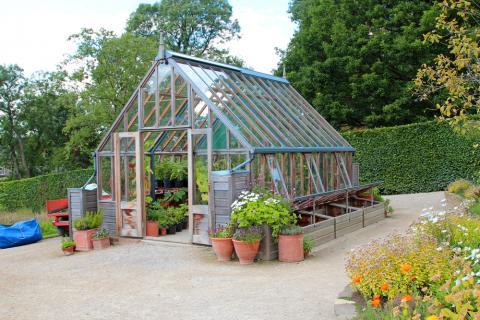
In the Northern Hemisphere, we are now in the heart of winter. We are, however, past the solstice, and the days will become lighter and lighter in smaller increments. If you think you are well beyond any type of growing possibilities, I want to suggest that it actually is possible to grow food in the winter. There are several different techniques that you can build yourself that will allow you to create a warm enough space to grow certain types of vegetables, even in the coldest of winters.
Common Methods for Growing in Winter
1. Greenhouse
If you are lucky enough to have a greenhouse or the ability to build one, you are in a fantastic position to grow a large amount of your own food. Experts in greenhouse design are able to build sustainable greenhouses that are capable of growing tropical plants, such as at the Central Rocky Mountain Permaculture Institute. Some people even build underground greenhouses that stay warm all winter! That being said, however, you do not have to have the most high-tech green house to have success growing cold hardy vegetables.
2. Covered Rows
Covered rows are ideal for the gardener who already has established beds and lives where the winter is mild. Covered rows are effective in colder areas when used inside a greenhouse. Otherwise, they are more for season extension. If, however, you do live where winter is mild, row covers are a very flexible way to grow in your own garden. The materials are simple, usually just piping and cover cloth, and they are easy to build when winter is in as well as remove once summer starts.
3. Hot Box/Cold Frame
Cold frames take a little more to build but are an excellent way to resource materials such as windows. They can be permanent in your landscape or semi-permanent, depending on how you want to use them. I know of a woman who uses her cold frame to successfully overwinter her rosemary bushes in the high desert of Utah. This permanent fixture is simply left open during the hot summer and kept closed in the winter. I have personally built a cold frame that can be moved in and out of the garden when I need it.
4. Indoors
The simplest technique is to grow your vegetables in your house. This technique requires some set-up, but this can be done at minimal cost. I like to set up a table near a window or sliding door in the house. If you do not have room for this, a table anywhere will do. I use sprouting trays to lay out my seeds and position a couple of lamps with a growing light near or above the trays.
When using grow lights indoors, it is extremely important to keep in mind that plants are just light humans in that they need darkness to rest. Do not leave the grow light on all the time. Your plants will come out spindly and weak. Instead, get into the routine of turning the light on and off every 12 hours to mimic the summer sun.
What to Grow in Winter
1. Spinach
Spinach is perhaps the most classic plant to grow in the winter. It is relatively quick to germinate and hardy to cold. You can grow spinach in any of the above mentioned techniques. You can either scatter a large amount of seed and then cut the baby spinach as it grows, or separate the seedlings so that larger, mature plants come out of the garden. The longer you let it grow, the hardier the spinach will be.
2. Salad Mix
Perhaps the quickest vegetables to grow, salad mix is used when you want to get fresh lettuce quickly. Salad mix is supposed to be scattered so that a mat of leaves pop out of the soil, which is then trimmed when ready to harvest. It is almost as if you were giving the lettuce a haircut! Salad mix can also be grown in any of the above contexts but is especially a great option when growing small amount indoors in seedling trays.
3. Carrots
Another classic, carrots should be planted in cold frames, greenhouses, or row covers. The aim of planting carrots in the winter is to have them ready to eat by spring. Follow the usual techniques for growing carrots, making sure you buy a variety that is cold hardy such as Napoli or Nelson varieties.
4. Cabbage
Cabbage, like carrots, are a longer-term crop and should be grown in greenhouses, cold frames, and row covers. There are some northern varieties of cabbages that are known for holding up, even under three feet of snow! They emerge from the snow melt in the spring ready to eat. Depending on your environment, you can select the appropriate variety of cabbage for your winter growing technique.
5. Sprouts
Sprouts, like lettuce mixes are ideal for the indoor growers with minimal space. If you are able to grow both sprouts and lettuce mix, you are well on your way to enjoying a spring salad in the middle of winter! Sprouts are not ideal to grow in a greenhouse, cold frame, or row cover context because they require careful monitoring of their moisture and are often plants that are not actually cold hardy. I recommend sunflower, buckwheat, and radish sprout varieties.
You can successfully grow your own vegetables in the winter even with the most basic growing setup. Whether you have a fully functioning greenhouse with banana palms, or you live in a tiny apartment with one window, you can grow your own food with just a little dedication. Avoid salad that has been shipped from across the world during your winter, take action, and enjoy taking part in your food creation!








